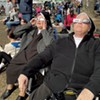Published April 14, 2004 at 6:25 p.m.
"Caller number five," the MC summoned a bearish, camouflage-clad man to the stage. "Please give us your rendition of the fly-down cackle.'"
Cupping his hands around his mouth, the subject used an instrument lodged between his tongue and the roof of his mouth to make a noise that sounded like, Cluk. Cluk. Cluk-cluk-cluk-cluk-cluk-cluk-cluk-cluk.
He was standing straight up when he started this odd utterance, but as it progressed, he swooped in a downward arc, as if he were flying out of a tree, and shuffled a few steps to the left. I would never have guessed this man was an artist, but seeing him prancing around, I thought I was witnessing some kind of wacky modern dance performance.
In fact, I was watching the Vermont State Turkey Calling Championships at the Smilie School in Bolton, an event sponsored each year by the National Wild Turkey Federation. The group's 1000 Vermont members are dedicated to keeping wild turkeys alive, so they can, well, kill them.
For many Americans, "wild turkey" conjures up either bourbon whiskey or Thanksgiving Day. But for Vermont's 14,000 turkey hunters, the phrase refers to the gobblers, hens and young "jakes" that roost in trees in nearly every town in the state. Though our national Turkey Day is still half a year away, the spring turkey season, which lasts throughout the month of May, is just around the corner. The fall season is October.
In past years, some areas of the state -- like parts of the Northeast Kingdom -- have been off limits to turkey hunters. This year, though, all of Vermont is fair game. As Bolton hunter Ron Lafreniere puts it, "The turkeys have done a tremendous job of proliferating."
The 46-year-old mail carrier sits on the board of the Vermont chapter of the National Wild Turkey Federation, and served as MC at the contest in Bolton two weeks ago. Despite his penchant for militaristic garb, soft-spoken Lafreniere is approachable and easy to talk to -- which is good for me, but not so great for the turkeys.
To see these birds in the wild, and to get a feel for what it's like to track them, I join Lafreniere for an early morning outing at Shelburne Bay Park. I'm not sure what to expect. Though I love hiking and camping, and have long considered myself an environmentalist, I've always been suspicious of hunters and their strident manliness.
It's still dark at 5:30 a.m. when I pull into the gravel parking lot and i.d. Lafreniere in his Chevy S-10 pick-up with its "GOBBLRS" license plate. Before heading down the trail to where the turkeys roost, I have to suit up. Lafreniere loans me a "Silent Shadow" camo jacket, some brown, black, and white camo gloves, and a camo-mesh face-mask. Apparently, turkeys have excellent eyesight and will scatter if they detect the slightest movement.
We enter the woods and hurry toward the place where Lafreniere scouted some birds the day before. On the way, he explains how turkey hunting works. Before sun-up, hunters head to a place where they think they'll find birds. Then they listen for the call of the male turkey, a.ka. the gobbler. "You gotta bust your butt to get within a hundred yards of a gobbler," Lafreniere tells me. "Then you set up in a place where you can call to him."
Calling is an essential skill for turkey hunters. Because the birds have highly developed eyesight and hearing, it's difficult to sneak up on them, and with all those hunters in the woods, it's safer to stay put and make the turkeys come to you. The male birds are bigger and, apparently, more expendable -- you can bag them twice a year, whereas killing a hen is legal only in the fall. So the calling consists primarily of "hen talk." In other words, turkey hunters are actually imitating the sounds made by female birds -- ironic considering the machismo of American hunting culture.
I enjoyed this amusing paradox at the Vermont State Turkey Calling Championships, where the 40 or so competitors were mostly big, beefy, bearded men. Many wore jeans or reinforced work-pants and camo shirts -- not exactly a gentle, dainty bunch of guys. But the display of their feminine turkey talk transformed them completely, even if I couldn't understand what they were saying.
The conversation between hunter and bird is what Lafreniere enjoys most about turkey hunting. "It's an interaction," he explains before our pre-dawn sojourn. "You're trying to communicate with the male, pique his interest a little bit, so he'll come and see you."
Lafreniere plans to demonstrate that interaction to me during our excursion. He wouldn't normally call to birds before the start of the season, as it might "educate them," but this particular park doesn't allow hunting, so he won't be ruining anyone's prospects by talking a little turkey. First, though, we have to find a few feathered friends to engage.
Just after we start down the path, the woods fill with bird song. "First the songbirds start," Lafreniere says, "then the crows, then the turkeys come in." I am following a few steps behind him when he hears the first gobble. He stops in his tracks. "There's one," he says. I miss it completely. It happens a couple more times before we come to a clearing. Light is beginning to color the sky pink. And then I hear it, off in the distance, "Gobblegobblegobble-obble-obble."
Like most Americans, I've been instructed all my life that turkeys go gobble gobble, but until this moment, I've never actually heard one --not in the wild, anyway. My first impression of the eerily alien and otherworldly song is that it sounds like something from a video game. My second thought is that the birds are saying something like, "Hey, sexy, the action's over here."
To pinpoint the gobblers' location, Lafreniere gets out a mouth call that looks like a long, conical party favor. He blows on it. A gobble rises up in reply. We head off the trail to see if we can get closer. As we crest a small hill, we spot several deer. They flash their white tails at us as they take off.
After traipsing through waist-high dried goldenrod and milkweed, we find a spot that's been picked over by the flock of turkeys we're tracking. Lafreniere points out dried white clumps of turkey turds. At one point we stop behind a stand of trees and hear some of the hens. I tell Lafreniere that I think I recognize a series of sounds called "the cutting of the excited hen." "No," he corrects me. "She's just yelping."
It isn't until we crest another hill and hide in a bunch of sumac that I see my first wild turkey, a male bird preening about 100 yards away. It looks like a brown spec until Lafreniere lends me a pair of binoculars. Then I make out its grayish head and neck, red wattles, and black, brown and white feathers. It puffs up and struts slowly back and forth, as if on parade. "He's trying to impress the hens," my guide suggests.
I don't see any hens at first, but slowly the flock wanders into view, and it's a big one. I count 45 birds in all. Of those, a dozen are big, fluffed-up gobblers. Lafreniere explains that the flock will probably shrink in a few weeks, as the hens drift off to nest. That will leave fewer prospects for the males, making them easier to entice.
Male turkeys have a strict and easily identifiable pecking order. I assume the bird out in front of the group is the leader, but Lafreniere sets me straight. Apparently the alpha bird travels in the middle, surrounded by all his ladies. The lesser males fan out along the edges. They're the ones that get picked off.
When we get up to leave just after eight, the flock starts to scatter. Lafreniere gets out a friction call -- an oblong wooden chamber covered by a paddle that scrapes along the top when you tap it -- and tries to sound like a yelping hen. The gobblers reply lasciviously. Through the binoculars, I watch one of the lesser toms stop his retreat and look up at us, intrigued.
"He's saying 'I know there's an excited hen up there,'" whispers Lafreniere. "He's wondering if he should come check us out." The hunter makes another call, and the gobbler stands there a few seconds before turning back toward the flock. Though we weren't planning to shoot him, Lafreniere seems a little disappointed.
Frankly, I don't mind. Tracking the birds is a treat, but I just don't have that killer instinct. On those rare occasions when I do eat meat, I'd rather let someone else slaughter it. As we leave the woods, my mind shifts from outdoor adventure to hunting down a breakfast bagel.
More By This Author
Speaking of...
-

Q&A: A Clinic Has Cared for Old North End Pets for Almost 20 Years
Jan 31, 2024 -

Video: The Old North End Veterinary Clinic Has Kept Costs Low to Help Pets in Burlington for Almost 20 Years
Jan 25, 2024 -

Q&A: Merrymac Farm Sanctuary in Charlotte Provides a Forever Home for Neglected Animals
Dec 6, 2023 -

Video: Neglected Animals Find a Home With Era MacDonald at Merrymac Farm Sanctuary in Charlotte
Nov 30, 2023 -

Response Teams Provide Shelter for Pets of Evacuated Vermonters
Jul 16, 2023 - More »
Comments
Comments are closed.
From 2014-2020, Seven Days allowed readers to comment on all stories posted on our website. While we've appreciated the suggestions and insights, right now Seven Days is prioritizing our core mission — producing high-quality, responsible local journalism — over moderating online debates between readers.
To criticize, correct or praise our reporting, please send us a letter to the editor or send us a tip. We’ll check it out and report the results.
Online comments may return when we have better tech tools for managing them. Thanks for reading.














































